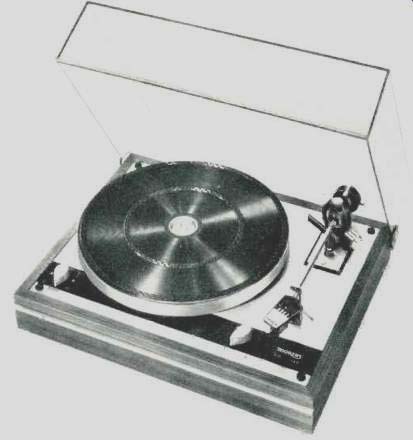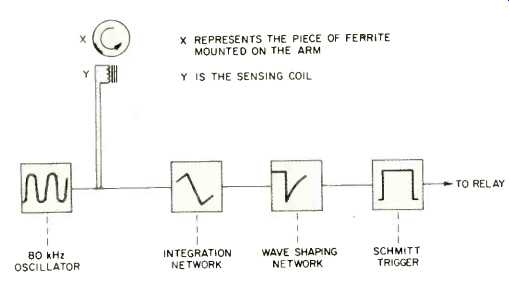
MANUFACTURER'S SPECIFICATIONS
Speeds: 33-1/3 and 45 rpm. Wow and Flutter: 0.06% DIN 45507. Rumble: -65 dB, weighted, DIN 45539. Lateral Tracking Error: Less than 0.2 deg./in. Bearing Friction: Less than 20 mg. Arm Resonance: Less than 10 Hz.
Cable Capacitance: 200pF (standard).
Dimensions: 17-in. W x 13 1/3-in. D x 7 3/4-in. H (including dust cover).
Weight: 16 1/2 lbs.
Price: $299.95.
Did you think that the Thorens TD 145C is merely a less expensive version of Elpa's TD 125 Mk II? The answer is no. Thorens TD 145C does incorporate individual features of its own, such as the motor top plate and pick-up arm which utilize an entirely different method of suspension than the 125 Mk II. This transcription turntable also has an ingenious electronic stop mechanism that lifts the tone arm at the end of a record. The arm and cue lifts on both units are similar, however, the 145C's 16-pole motor is driven direct from the power line instead of by a transistor generator. And, like the 125, the motor is coupled to the turntable flywheel by a belt, but the speed change is made by a mechanical link which moves the belt on the two-dimensional motor shaft. The speed selector knob is at the front on the left and has three positions-the center one switching the motor off. On the right, a matching knob operates the pick-up cueing or lifting device, which uses a black plastic bar just in front of the arm pivot. The lift also becomes operational at the end of a record; first, as the phono stylus travels into the run-off grooves, the arm rotates, bringing a tiny ferrite section near a sensing coil, thus pulsing an 80-kHz oscillator. The pulse is integrated, as shown in the accompanying figure, and operates a Schmitt trigger circuit which causes a decrease in current through a solenoid. As the lever springs back, it operates the motor switch and a microswitch which activates the cue lift device. Although it sounds quite complicated, it really is a straightforward arrangement, though it does use five transistors, three diodes, plus a 30V supply, and thus must add to the overall cost of the unit.

Fig. 1--X represents the piece of ferrite mounted on the arm. Y is the sensing
coil.
Measurements
As previously mentioned, the arm is similar to the one used on the TD 125 Mk II, and it is just over 9 in. long, with a slide-on counterweight at the rear. The stylus-force fine adjustment is a thumbwheel mounted above the pivot, and it is calibrated in 1/4-gm. steps from 0.5 to 3 gms. The anti-skating control is located to the right of the pivot, and it works by applying a magnetic force to compensate for the inherent tendency of the arm to swing towards the center of the record. The dial is calibrated for elliptical and conical styli with a provision for "wet play"-popular in some European circles-a practice I would not recommend!
(Editor's Note: For those interested in additional information on the wet play system, we refer them to F. A. Loescher's article "Record and Stylus: How Long Do They Last?" in the June 1975 issue of the British publication Gramophone, whose circulation office is at 177-179 Kenton Rd., Harrow, Middlesex HA3 OHA, England.)
Motor speed is 450 rpm. The 4 1/2-Ib. cast aluminum turntable rests on a heavy flywheel. Both the motor and the base of the arm are mounted on a sub-panel which is spring mounted from the main top-plate. This arrangement is preferable to the more commonly used suspension systems as it is less susceptible to acoustic feedback, and there is no indication of any wow when the controls are operated! The cartridge shell is easy to detach, and no trouble was experienced in mounting my standard ,cartridge, a Shure V-15 Mk III; with the hardware supplied. The alignment template was used to make certain that tracking was accurate, and then the arm was balanced with the counterweight and tracking force set. The Shure test record was used for this adjustment, and the optimum force was found to be 1 1/4 gms. with the anti-skating dial turned to 1 1/2.
Tracking error was within the 0.5 degs./in.-typically good for this kind of arm. Lateral and vertical friction were both too low to measure with any degree of accuracy. Wow and flutter was extremely low at 0.05% (DIN 45507), and rumble was -65 dB (RRLL weighting) which is one of the lowest figures yet encountered. The stylus force dial calibration was found to be accurate, certainly within 5%, and the arm resonance with the Shure cartridge came out at 8 Hz with a rise of only 3.5 dB. The cue arm lift works easily and smoothly without side-play with an almost instantaneous lift and a gentle three-second drop. The motor is exceptionally quiet, and speed on both ranges was less than 1 per cent fast. At the end of the record, the motor is automatically switched off and the arm raised from the record. However, the arm does not return to the rest position, which can be disconcerting until you get used to it; this is minor, and there are no other criticisms.
For those desiring Model TD 125 Mk II, but can do without the refinement of variable speed control, the TD 145C is a quite logical choice, as the difference between the two models' basic performance is minimal. Incidentally, the connecting cables supplied are not suitable for CD-4 applications, but Thorens can supply low-capacity cables if required. The part number is LCC-1.
-George W. Tillet
(Audio magazine, Mar. 1976)
Also see:
Thorens TD-126C Turntable (Dec. 1977)
Thorens TD 115 Turntable / Ortofon TPO-70 phono cartridge wand (Dec. 1982)
Thorens TD 320 Turntable and TP 16 MK III Tonearm (Mar. 1987)
SOTA Cosmos Turntable / SME 309 Arm & Signet OC9 Cartridge (Sept. 1990)
= = = =